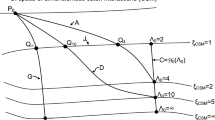Abstract
Much apprehension has been expressed by philosophers about the method of renormalisation in quantum field theory, as it apparently requires illegitimate procedure of infinite cancellation. This has lead to various speculations, in particular in Teller (1989). We examine Teller's discussion of perturbative renormalisation of quantum fields, and show why it is inadequate. To really approach the matter one needs to understand the ideas and results of the ‘renormalisation group’, so we give a simple but comprehensive account of this topic. With this in hand, we explain how renormalisation can and should be understood. One thing that is revealed is that apparently very successful theories such as quantum electro-dynamics cannot be universally true; resolving the tension between success and falsity leads to a picture in which any theory may be viewed as irreducibly phenomenological. We explain how, and argue that the support for this view is tenuous at best.
Similar content being viewed by others
References
Appelquist, T. and J. Carazzone: 1975, ‘Infrared Singularities and Massive Fields’,Phys. Rev. D. 11, 2856–61.
Bruce, A. and D. Wallace: 1989, ‘Critical Point Phenomena: Universal Physics at Large Length Scales’, in P. Davis (ed.),The New Physics, Cambridge University Press, Cambridge, pp. 236–67.
Cao, T. Y. and S. Schweber: 1993, ‘The Conceptual Foundations and Philosophical Aspects of Renormalization Theory’,Synthese 97, 32–108.
Cheng T-P. and L-F. Li: 1988,Guage Theory of Elementary Particle Physics, Clarendon Press, Oxford.
Gell-Mann, M. and F. E. Low: 1954, ‘Quantum Electrodynamics at Short Distances’,Phys. Reps. 95, 1300–12.
Georgi, H. M.: 1989a, ‘Grand Unified Field Theories’, in P. Davis (ed.),The New Physics, Cambridge University Press, Cambridge, pp. 425–45.
Georgi, H.: 1989b, ‘Effective Quantum Field Theories’, in P. Davis (ed.),The New Physics, Cambridge University Press, Cambridge, pp. 46–57.
Kadanoff, L.P.: 1966, ‘Scaling Laws for Ising Models Near Tc’,Physics 2, 263–72.
Ma, S-K.: 1976,Modern Theory of Critical Phenomena, Addison-Wesley, Redwood City, California.
Maris, H. J. and L. P. Kadanoff: 1978, ‘Teaching the Renormalisation Group’,Am. J. Phys. 46, 652–7.
Polchinski, J.: 1984, ‘Renormalisation and Effective Lagrangians’,Nuclear Physics 231B, 269–95.
Redhead, M.: 1988, ‘A Philosopher Looks at Quantum Field Theory’, in H. R. Brown, and R. Harre (eds.),Philosophical Foundations of Quantum Field Theory, Clarendon Press, Oxford, pp. 9–23.
Robinson, D.: 1992, ‘Renormalization and the Effective Field Theory Programme’, in D. Hull et al. (eds.),Proceedings of the PSA 1992, PSA, East Lansing, pp. 393–403.
Shenker, S.: 1984, ‘Field Theories and Phase Transitions’, in J. Zuber and R. Stora (eds.),Recent Advances in Field Theory and Statistical Mechanics: Les Houches Volume 39, Elsevier, New York, pp. 4–19.
Teller, P.: 1989, ‘Infinite Renormalisation’,Philosophy of Science 56, 238–57.
Teller, P.: 1990, ‘Prolegomenon to a Proper Interpretation of Quantum Field Theory’,Philosophy of Science 57, 594–618.
Weinberg, S.: 1978, ‘Critical Phenomena for Field Theorists’, in Zichichi (ed.),Understanding the Fundamental Constituents of Matter, Plenum Press, New York, pp. 1–52.
Weingard, R.: 1988, ‘Virtual Particles and the Interpretation of Quantum Field Theory’, in H. R. Brown and R. Harre (eds.),Philosophical Foundations of Quantum Field Theory, Clarendon Press, Oxford, pp. 43–58.
Wilson, K.G. and Kogut, J.: 1974, ‘The Renormalization Group and the Expansion’,Phys Reps. 12C.2, 75–200.
Author information
Authors and Affiliations
Additional information
We are very grateful to Stephen Shenker in his patient efforts to help us understand this material, and to the helpful comments of Paul Teller and two anonymous referees. Some of the ideas presented here are based on material in the Ph.D. thesis of one of us (Huggett) submitted to Rutgers University.
Rights and permissions
About this article
Cite this article
Huggett, N., Weingard, R. The renormalisation group and effective field theories. Synthese 102, 171–194 (1995). https://doi.org/10.1007/BF01063904
Issue Date:
DOI: https://doi.org/10.1007/BF01063904




